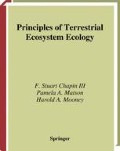Abstract
Ecosystem processes constantly change in response to variation in environment over all time scales. This chapter describes the major patterns and controls over the temporal dynamics of ecosystems.
Access this chapter
Tax calculation will be finalised at checkout
Purchases are for personal use only
Preview
Unable to display preview. Download preview PDF.
Additional Reading
Bazzaz, F.A. 1996. Plants in Changing Environments. Linking Physiological, Population, and Community Ecology. Cambridge University Press, Cambridge, UK.
Bormann, F.H., and G.E. Likens. 1979. Pattern and Process in a Forested Ecosystem. Springer-Verlag, New York.
Chapin, F.S. III, L.R. Walker, C.L. Fastie, and L.C. Sharman. 1994. Mechanisms of primary succession following deglaciation at Glacier Bay, Alaska. Ecological Monographs 64:149–175.
Clements, F.E. 1916. Plant Succession: An Analysis of the Development of Vegetation. Publication 242. Carnegie Institution of Washington, Washington, DC.
Connell, J.H., and R.O. Slatyer. 1977. Mechanisms of succession in natural communities and their role in community stability and organization. American Naturalist 111:1119–1114.
Crocker, R.L., and J. Major. 1955. Soil development in relation to vegetation and surface age at Glacier Bay, Alaska. Journal of Ecology 43:427–448.
Fastie, C.L. 1995. Causes and ecosystem consequences of multiple pathways of primary succession at Glacier Bay, Alaska. Ecology 76:1899–1916.
Vitousek, P.M., and W.A. Reiners. 1975. Ecosystem succession and nutrient retention: A hypothesis. BioScience 25:376–381.
Vitousek, P.M., L.R. Walker, L.D. Whiteaker, D. Mueller-Dombois, and P.A. Matson. 1987. Biological invasion by Myrica faya alters ecosystem development in Hawaii. Science 238:802–804.
Zimov, S.A., V.I. Chuprynin, A.P. Oreshko, F.S. Chapin III, J.F. Reynolds, and M.C. Chapin. 1995. Steppe-tundra transition: An herbivore-driven biome shift at the end of the Pleistocene. American Naturalist 146:765–794.
Rights and permissions
Copyright information
© 2002 Springer-Verlag New York, Inc.
About this chapter
Cite this chapter
(2002). Temporal Dynamics. In: Principles of Terrestrial Ecosystem Ecology. Springer, New York, NY. https://doi.org/10.1007/0-387-21663-4_13
Download citation
DOI: https://doi.org/10.1007/0-387-21663-4_13
Publisher Name: Springer, New York, NY
Print ISBN: 978-0-387-95439-4
Online ISBN: 978-0-387-21663-8
eBook Packages: Springer Book Archive

